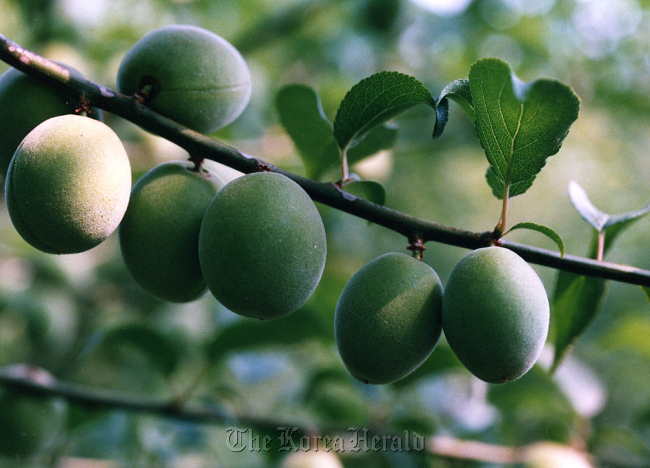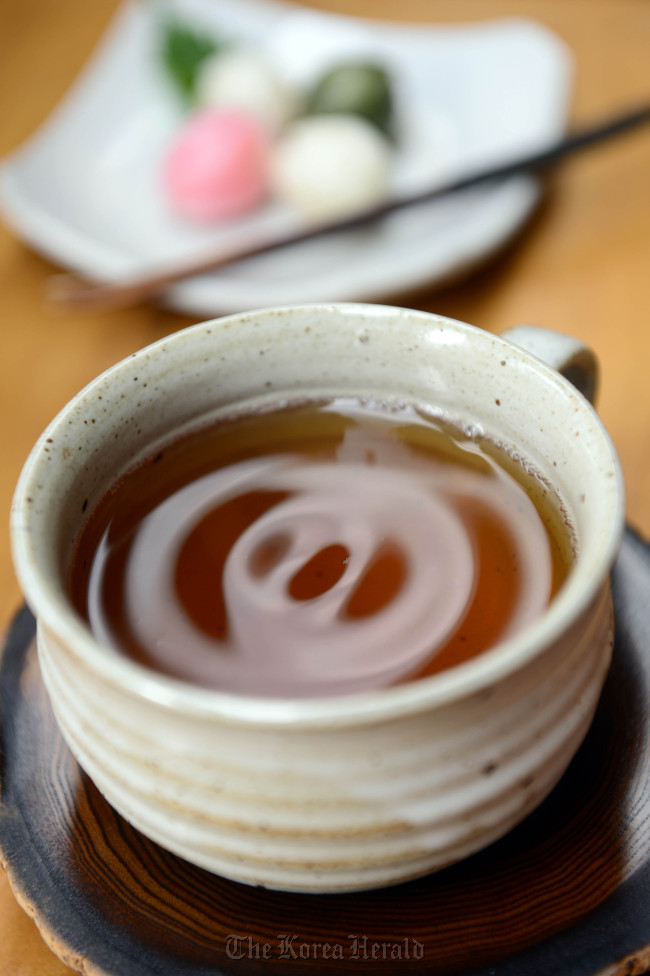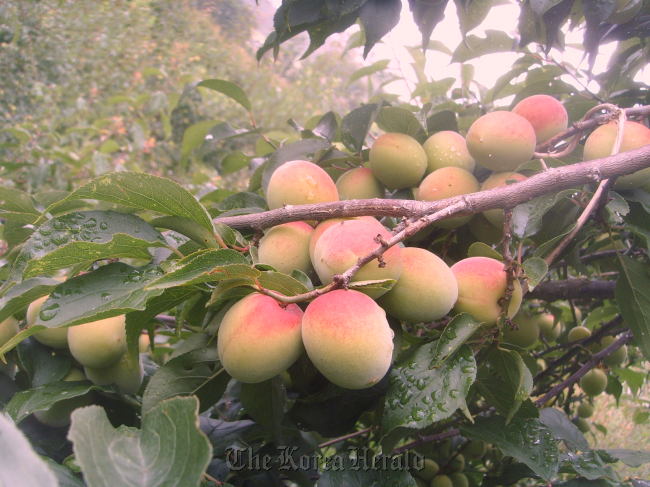Summer fruit ready to be made into an extract that doubles as seasoning and tea
In South Korea, it is called “maesil,” in Japan, “ume” and in China, “meizi.” In English, this sour, mouth-puckering fruit often goes by Japanese apricot or Chinese plum. Whatever the name, it is now in season.
Though not consumed raw for various reasons including the potential presence of toxins within the seeds, when fermented into an extract it can be used as a seasoning or to make tea.
The extract can range from sugary and floral to slightly tart with a wine-like depth; and because maesil is generally harvested in June or July, now is the time to start making it.
When this time of year rolls around, boxes of the fragrant plums are hauled home and bags of sugar and huge jars are brought out. Alternating layers of clean, green maesil and sugar are stacked in jars and left in a cool, dry place to ferment.
In South Korea, it is called “maesil,” in Japan, “ume” and in China, “meizi.” In English, this sour, mouth-puckering fruit often goes by Japanese apricot or Chinese plum. Whatever the name, it is now in season.
Though not consumed raw for various reasons including the potential presence of toxins within the seeds, when fermented into an extract it can be used as a seasoning or to make tea.
The extract can range from sugary and floral to slightly tart with a wine-like depth; and because maesil is generally harvested in June or July, now is the time to start making it.
When this time of year rolls around, boxes of the fragrant plums are hauled home and bags of sugar and huge jars are brought out. Alternating layers of clean, green maesil and sugar are stacked in jars and left in a cool, dry place to ferment.

When ready ― the aging period can run anywhere from 100 days to three years ― the extract is added to hot or cold water as a beverage, or to spice up dishes when cooking. It is, essentially, a household staple.
“Most houses have some maesil extract,” said Martha Hwang from traditional tea house Moon Hyang Jae, where maesil tea and maesil extract are sold. “You can put a spoonful of the extract into a meat marinade or when you saute fish.”
“It is believed that maesil extract is effective at getting rid of gamey scents in food,” Hwang explained why it is commonly used as a seasoning.


“We also add it to water when our children have upset stomachs,” she added. “Many enjoy the tea as a post-meal digestif and it also said to be good for hangovers.”
According to the official website of maesil producer Chungmewon (www.mesil.net), the plum has high mineral and vitamin content and was used in traditional Korean medicine in the past.
In short, it has been consumed as a health food for centuries.
While it is most commonly enjoyed as an extract, it can also be made into a wine and the fruit can be pickled and enjoyed as a “banchan,” or side dish.
The versatile nature of the fruit is evidenced by Chungmewon’s ability to take the “namgo” varietal of maesil raised on its farm in South Jeolla Province and whip out 18 different products.
Chungmewon makes everything from a particularly toothsome jam to a sweet, fiery gochujang-slathered pickle with those plums.
The namgo varietal raised at Chungmewon possesses a ruddy, blush hue and, according to Chungmewon president Kim Young-sub, “is firm-fleshed, preserves well and possesses a deep fragrance that makes it ideal for making maesil tea or wine.”
While it is easier to purchase the products ready-made, here are some tips and recipes from Chungmewon for those who want to try make them at home.
Maesil tips
Chungmewon president Kim Young-sub emphasizes the importance of buying maesil after June 5 this year, when the seed has ripened and hardened.
Here are Kim’s guidelines for when to make maesil pickles, wine and tea for namgo and other varietals as well.
June 10 ― 15: Maesil pickles
June 15 ― 20: Maesil wine
After June 20: Maesil tea, when the fruit has ripened a bit, for a fragrant extract
Where to buy
Chungmewon’s maesil products including jam, pickles and extract are sold at the Myeongin Myeongchon corner located at 10 Hyundai Department Stores nationwide.
Moon Hyang Jae; 106-2 Hwadong, Jongno-gu, Seoul; (02) 720-9691; open from noon to 10 p.m. daily; maesil tea costs 6,000 won hot or cold, maesil extract costs 25,000 won per liter, maesil pickles cost 50,000 won for 500 grams
By Jean Oh (oh_jean@heraldcorp.com)
Maesil tea extract
Ingredients:
● 10kg maesil
● 10kg sugar
Directions
1. Select thick-fleshed maesil, wash and then dry.
2. Alternate layers of maesil and sugar in a sterilized, large-mouthed jar. When nearly done, put a final, thick layer of sugar on top and then seal and store in a cool, dark place.
3. After 15 days, when the sugar has liquefied, stir occasionally.
4. If the namgo varietal has been used then ferment extract for at least six months, then strain and boil lightly to get rid of any hint of alcohol. After the mixture cools, put it in a sterilized jar and store in a cool place. (Note: The fermentation period varies from recipe to recipe. According to Hwang, Moon Hyang Jae’s maesil tea, for example, is made from an extract that has been fermented for 100 days. Chungmewon’s Kim says to adjust fermentation period for other varietals.)
5. Add an adequate amount of the resulting syrup to cold, hot or warm water and drink. Moon Hyang Jae’s Hwang recommends a 3-to-1 ratio of water to extract when making tea.
Maesil pork belly
Ingredients:
● 200g samgyeopsal (pork belly)
● 10 ml maesil wine or maesil extract mixed with soju
● 1/3 tsp salt
● 1/4 tsp black pepper
● 20 cm cooking foil
Directions
1. Prepare 200g pork belly and season with salt and pepper.
2. Marinate the pork belly in maesil wine or maesil extract that has been mixed with soju for three to six hours in the refrigerator.
3. Wrap the marinated pork belly in cooking foil and store in freezer for use whenever needed or grill right away.
(Recipes courtesy of Chungmewon)
-
Articles by Korea Herald








![[Today’s K-pop] BTS pop-up event to come to Seoul](http://res.heraldm.com/phpwas/restmb_idxmake.php?idx=644&simg=/content/image/2024/04/17/20240417050734_0.jpg&u=)

![[Graphic News] More Koreans say they plan long-distance trips this year](http://res.heraldm.com/phpwas/restmb_idxmake.php?idx=644&simg=/content/image/2024/04/17/20240417050828_0.gif&u=)






![[KH Explains] Hyundai's full hybrid edge to pay off amid slow transition to pure EVs](http://res.heraldm.com/phpwas/restmb_idxmake.php?idx=652&simg=/content/image/2024/04/18/20240418050645_0.jpg&u=20240419100350)

